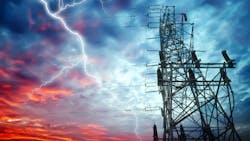The United States power grids are at the center of a significant transformation that will ultimately lead to the decarbonization of all economic sectors, the increase of distributed renewable generation and the electrification of consumption.
In this context, the U.S. committed to ambitious targets: reduce net greenhouse gas emissions 50-52% below 2005 levels by 2030 and reach 100% clean electricity by 2035. These goals involve an integrated strategy of investment, innovation, and new technology deployment not just for transmission but also for distribution networks.
To accomplish this, the current U.S. Administration allocated approximately $500 billion to fund the development of new infrastructure over the next five years, through the Infrastructure Investment and Jobs Act in the framework of the Build Back Better Act.
Power distribution networks are often the less visible side of the electricity system, but they are on track to undergo a major digitalization and modernization into smarter grids. Distribution grid infrastructure investments can enhance resilience, improve reliability, better integrate renewable generation sources, lower electricity costs, and unlock the best clean energy resources by connecting them to demand centers.
Grid Resilience and Reliability
Grid resilience has been associated in the last few years to the transformation of the infrastructure to withstand more severe and frequent climate events that increasingly affect the US due to changes in climate patterns. Electrical system in many parts of the US have been impacted by hurricanes, wildfires, thunderstorms, and other extreme weather events, leading to outages.
But resilience today means more than adapting power infrastructures to climate change. In many parts of the US, utilities are no longer the dominant producers of electricity, and generation from distributed energy resources (DERs) has increased exponentially also thanks to the 2035 goal to eliminate carbon emissions set by the Biden administration.
The adoption of DERs such as rooftop solar, customer-sited energy storage and electric vehicles, is growing rapidly. This growth is supported by a change in electricity customer needs and expectations, and their interest in reducing energy bills. However, effective integration of DERs requires visibility to and controllability by the distribution grid operator at local level and that’s why modernizing the grid’s core components is vital.
Moreover, a report from the American Society of Civil Engineers states that 70% of transmission and distribution lines in the US are old, already in the second half of their expected 50-year lifespan.
According to U.S. federal data, the number of large, sustained outages have increased in frequency over the past two decades. For comparison, there were less than two dozen major disruptions in 2000, whereas 2020 saw the number surpass 180.
Severe weather, coupled with an aging and overstressed electrical infrastructure, is having a dramatic impact on the population and is increasing the need to deploy technologies that can mitigate future power outages, save lives, and protect property.
Having resilient and reliable power is critical for vital services such as healthcare, transportation and financial systems. When smart technologies are in place, power outages can be avoided and lives, homes, and businesses are protected.
Gridspertise – digitalization solutions for Grid Resilience showcased at Distributech
Gridspertise, a new company born out of Enel, the world’s largest privately owned operator of power distribution grids with more than 20 years of expertise in the field, is ready to contribute significantly to this plan.
The NewCo offers innovative, flexible, sustainable and integrated solutions and services, in three main areas of transformation:
- Metering and grid edge digitalization: Reliable, advanced and interactive metering solutions that allow grid efficiency and customer engagement. Solutions include smart meters devices, data management software and low voltage grid analytics.
- Network infrastructure digitalization: Smart grid solutions to enhance resiliency, efficiency and sustainability, as well as boost the quality of service. Examples include integrated solutions for grid operations, from grid monitoring to remote control, automation, electrical flow and flexibility management of distributed resources, and disruptive technologies such as the QEd - Quantum Edge® device.
- Field operations digitalization: Digital solutions and devices, such as the Network Digital Twin® and Weather Alerting and Forecasting, to streamline field operations, reducing response time and increasing worker safety.
- With the aim of being a trusted partner for utilities worldwide and supporting the digital transformation of networks into sustainable and reliable smart grids, Gridspertise offers solutions that address these needs through cloud and edge platform technologies, providing benefits for the entire North American electric ecosystem:
- Internal to utilities: Improves the resilience and quality of service, optimizes investments in new infrastructure and enhances field operations’ safety, productivity and sustainability.
- For grid stakeholders: Integrates distributed energy resources, facilitates the development of energy service market, including electrification of end uses, through the platform.
- For end customers: Increases the reliability of electricity supply, facilitates electrification, fosters energy efficiency and allows end customers to participate in energy markets as prosumers.
In the past months, Gridspertise announced the signing of thirteen agreements for more than 670,000 smart meters and over 150,000 field devices and accessories across four European countries.
Gridspertise also presented the QEd, a revolutionary all-in-one solution that virtualizes key grid functionalities through customizable applications. Thanks to a multi-purpose edge platform, the required components in the secondary substation as well as the number of field interventions can be reduced.
The QEd leverages Qualcomm Technologies’ industrial-grade IoT solutions featuring the latest 5G, compute, security, and AI capabilities.
The two companies also announced a new strategic collaboration to explore opportunities for the joint development of new solutions to digitally transform electric utilities, taking into account the US market needs.
Gridspertise will participate in Distributech International in Dallas from the 23rd to the 25th of May as sponsor, opening the event with an introductory speech at the Breakfast Roundtable and showcasing its expertise in grid edge digital solutions for grid resilience at its booth. This represents a great opportunity to get in contact with US utilities and establish new partnerships to accelerate the electric future.
Sponsored By:

